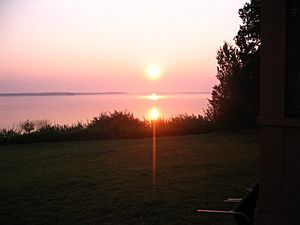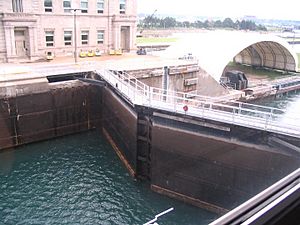Manistique Lakes facts for kids
The Manistique Lakes are a group of three beautiful lakes located in the Upper Peninsula of Michigan. These lakes are North Manistique Lake, Big Manistique Lake, and South Manistique Lake. Nearby towns include Curtis, Germfask, and Helmer. People love to visit these lakes for vacations and fishing. They are also close to other amazing natural places like the Great Lakes, rivers, and smaller lakes. Plus, there are fun tourist spots nearby, such as the Canada–US border, the Soo Locks, and Mackinac Island.
Contents
North Manistique Lake
North Manistique Lake is found in Luce County, Michigan. It covers about 1,700 acres of water. Fresh water flows into the lake from springs on its northern and eastern sides, and from an inlet on the west. The only way water leaves the lake is through Helmer Creek, which flows south into Big Manistique Lake. Many homes and businesses are built along the shoreline. There are also public areas like county parks and boat launches for everyone to enjoy.
The bottom of North Manistique Lake is shaped like a bowl. It has some shallow, flat areas and a deeper part in the middle. Almost half of the lake is less than 15 feet deep, but its deepest point is about 50 feet.
In the deep parts of the lake, the bottom is made of peat, which is like decayed plant matter. In the shallow areas, you'll find sand and marl, a type of clay. There's also a shallow rock reef on the western shore. While not many water plants grow here, you might see rushes, Chara, and Potamogeton.
Fish Community and Reproduction
North Manistique Lake is home to many fish species, similar to other lakes in Michigan, Minnesota, and Wisconsin. Some popular fish you can find here include walleyes, northern pike, perch, trout, splake, and smallmouth bass.
People have helped increase the fish population by stocking the lake with fish for many years. For example, walleyes and yellow perch were first stocked in the 1930s. Rainbow trout and northern pike have also been added over time. Since the late 1970s, many young walleyes have been stocked to help their numbers grow.
Anglers (people who fish) have caught some impressive fish here! Between 1994 and 2000, rock bass and smallmouth bass from North Manistique Lake won eleven State of Michigan Master Angler awards.
Big Manistique Lake
Big Manistique Lake is also known simply as Manistique Lake. It stretches across parts of Luce County and Mackinac County in Michigan. This is the largest of the three Manistique Lakes, covering about 10,000 acres. Helmer Creek flows into the north side of the lake, bringing water from North Manistique Lake. Portage Creek flows into the south side, bringing water from South Manistique Lake.
The Portage Creek has a dam that helps control the water level in South Manistique Lake for summer fun. This dam also lets fish travel between the lakes. Helmer Creek is a trout stream with its own dam, the Tressler Dam, which helps fish move downstream easily. The Manistique River flows out of the west side of Big Manistique Lake and eventually reaches Lake Michigan. There's another dam, the Manistique Lake Dam, downstream from the lake. This dam stops fish from moving from the Manistique River back into Big Manistique Lake.
Like North Manistique Lake, the shores of Big Manistique Lake have both private homes and businesses. There are also four public boat launches, making it easy for everyone to get on the water.
The lake bottom is mostly flat, with a maximum depth of about 20 feet. Most of the lake is less than 15 feet deep. In the shallow areas, the bottom is made of sand, gravel, and rock. In deeper spots, you'll find sand and organic matter. Water plants are not very common, but you can find them in shallow areas and in underwater beds.
Fish Community and Reproduction
Big Manistique Lake is home to many different types of fish. You can find minnows, white suckers, and different kinds of redhorse fish. There are also popular panfish like yellow perch and rock bass, and even lake herring. Walleye and bluegill are also common.
Efforts have been made to stock the lake with fish over the years. Young walleyes were stocked in the 1930s, and again from the 1970s to 1980, and in 2005. Lake sturgeon were stocked in the 1980s and 1990s, and smallmouth bass were added in 1998.
Between 1994 and 2005, northern pike, rock bass, and smallmouth bass from Big Manistique Lake won three State of Michigan Master Angler awards.
South Manistique Lake
South Manistique Lake is also known as Whitefish Lake. It covers about 4,000 acres. This lake is located in the northwestern part of Mackinac County, near the towns of Portage, Michigan and Newton Township. The town of Curtis, Michigan, sits between South Manistique and Big Manistique lakes, right on the northern shore of South Manistique. The land around the lake is a beautiful wetland with woods, flowers, and sandy soil.
Four streams flow into South Manistique Lake: Norton Creek, Taylor Creek, Strom Creek, and Shoepac River. The only way water leaves the lake is through Portage Creek in Curtis, which then flows into Big Manistique Lake.
The deepest part of South Manistique Lake is 29 feet. The shoreline is made of sand, muck, and fibrous peat. Unlike the other two lakes, South Manistique Lake has more aquatic plants. You might see Chara, Potomegaton, bladderwort, flatstem pondweed, northern milfoil, lily pads, cattails, bulrushes, and common naiad.
There are four public boat launches available. One is owned by the town of Curtis, and three are owned by the Michigan Department of Natural Resources. This lake is very popular for summer activities like boating and swimming, and for ice fishing in the winter.
Fish Community and Reproduction
Walleye fish are a very important species in South Manistique Lake. The lake was stocked with walleyes from the early 1970s to the mid-1990s. After that, the walleye population started to grow naturally, meaning they could reproduce on their own. Bluegill fish have had some challenges here because many are caught by anglers, and they are also eaten by predators like walleyes and other large fish.
Other fish species found in South Manistique Lake include yellow perch, smallmouth bass, largemouth bass, rainbow trout, and splake. Muskellunge fish were stocked in 1972 and then every two to four years after 1980. While muskellunge stocking slowed down in the 1990s, it still continues. Most fish populations in South Manistique Lake are now maintained by natural reproduction.
Aquatic Plants
Water plants in lakes are super important! They are a main food source for many creatures like bacteria, fish, waterfowl, insects, and mammals. This is because plants use sunlight and nutrients to create living tissue that these organisms can eat. The roots of these plants also create diverse environments underwater, which is very important for fish to reproduce and find shelter.
Fun Activities and Tourism
People visit the Manistique Lakes all year round because there are fun activities for both warm and cold weather. You can rent cabins from local companies in the nearby towns, making it easy to stay and play.
Warm Weather Fun
Warmer temperatures usually start in late April. This is when activities like fishing, swimming, snorkeling, and water skiing become popular. You can rent boats, motors, and jet skis from local shops. There are many public access points on the lakes in Curtis, Michigan, perfect for boating and personal watercraft.
Cold Weather Fun
Ice starts to form on the lakes in early December. From late December to mid-April, you can enjoy winter sports and ice fishing events.
Cool Places to Visit Near Manistique Lakes
- Tahquamenon Falls State Park has the amazing Tahquamenon Falls. Here, you can go bird-watching, fishing, hiking, sightseeing, camping, snowmobiling, and skiing.
- Big Springs "Kitch-iti-kipi" is Michigan's largest natural freshwater spring.
- Seney National Wildlife Refuge is a great place to observe many different kinds of wildlife.
- Crisp Point is one of the lighthouses located on the shore of Lake Superior.
- Garlyn Zoo is found at the top of Lake Michigan and has both local and exotic animals.
- Pictured Rocks National Lakeshore is a beautiful park on Lake Superior. It features beaches, cliffs, sand dunes, waterfalls, lakes, and forests.
- Fayette Historic State Park offers forests, cliffs, and a harbor on Lake Michigan to explore.
- Oswald's Bear Ranch is the biggest bear ranch in the United States.
- Toonerville Trolley is a fun railroad ride that goes through a forest with lots of wildlife, leading to the Tahquamenon River.
- The Tahquamenon River Logging Museum shows artifacts from the days of lumberjacks and has a nature trail through the Tahquamenon Forest.
- The Soo Locks is the world's largest waterway traffic system, located in Sault Ste Marie, Michigan.
- Mackinac Island is a historic island between the Upper Peninsula and Lower Peninsula of Michigan. It's a great place to learn about the history of the United States, the Great Lakes, and Michigan.
- Mackinac Bridge is a huge bridge that connects the upper and lower peninsulas of Michigan, allowing cars to travel between them.
- Great Lakes Shipwreck Museum displays artifacts from shipwrecks found in the Great Lakes. It's located at Whitefish Point, Michigan.
- The Two Hearted River is known as one of Michigan's "Wild Rivers."
Rivers Near Manistique Lakes
- The Manistique River flows from the west end of Big Manistique Lake all the way to Manistique, Michigan, where it empties into Lake Michigan. This river is about 80 miles long and usually 2 to 10 feet deep. Its bottom is made of sand and gravel. It's a great spot for canoeing, kayaking, rafting, and fishing for northern pike, smallmouth bass, and walleye.
- The Fox River starts in Alger County and Northern Schoolcraft County. There are four campgrounds along this river. It's known for having a large population of brook trout for fishing.
- The Two Hearted River connects Dawnson Creek to the East Branch of the river. You can enjoy wading, canoeing, and fishing for brook and rainbow trout here.
- The Tahquamenon River is perfect for canoeing and fishing for brook and brown trout, walleyes, and muskellunge.




